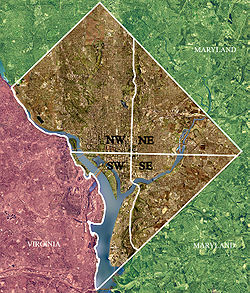
Back Kuadran di Washington, D.C. ID Kvadranter i Washington, D.C. Swedish واشنگٹن ڈی سی کے کواڈرینٹ Urdu
This article needs additional citations for verification. (August 2016) |

Washington, D.C., is administratively divided into four geographical quadrants of unequal size, each delineated by their ordinal directions from the medallion located in the Crypt under the Rotunda of the Capitol. Street and number addressing, centered on the Capitol, radiates out into each of the quadrants, producing a number of intersections of identically named cross-streets in each quadrant.[clarification needed] Originally, the District of Columbia was a near-perfect square but contained more than one settlement; the Capitol was to be the center of the City of Washington. Thus, the Capitol was never located at the geographic center of the whole territory, which was eventually north of the Potomac River, consolidated into one city. (The geographic center was located near the onetime marshy area of the present-day intersection of 17th Street, NW and Constitution Ave.) As a result, the quadrants are of greatly varying size. Northwest is quite large, encompassing over a third of the city's geographical area, while Southwest is little more than a few neighborhoods, large parks, and a military base.
The boundaries of the quadrants are not necessarily straight lines radiating from the medallion, but in three instances follow the paths of the boundary streets (which in some cases curve around topographical features): North Capitol Street, South Capitol Street, and East Capitol Street. The axis of the National Mall through the Washington Monument and the Lincoln Memorial forms the boundary running west of the medallion.